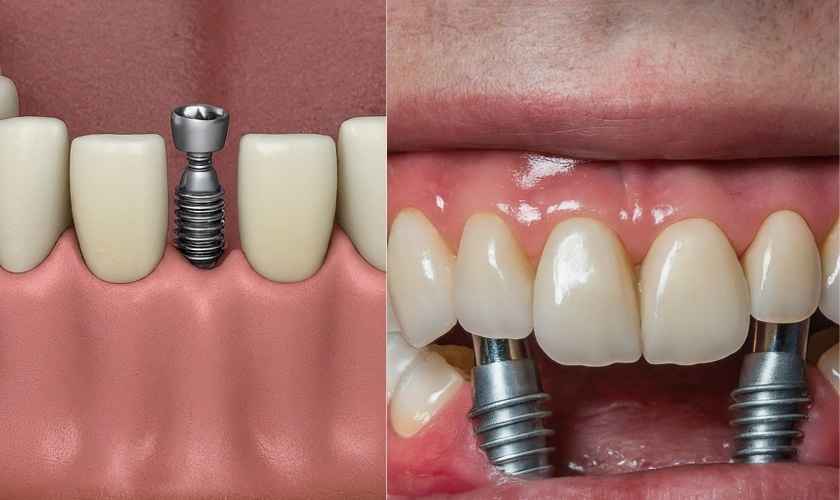The 9-Second Trick For Dental Sense
Table of ContentsSee This Report about Dental SenseLittle Known Questions About Dental Sense.Some Known Questions About Dental Sense.The Facts About Dental Sense Uncovered
are clinical gadgets operatively implanted into the jaw to restore a person's capability to eat or their appearance. They offer support for artificial (fake) teeth, such as crowns, bridges, or dentures. When a tooth is shed because of injury or condition, an individual can experience issues such as fast bone loss, malfunctioning speech, or changes to eating patterns that result in discomfort.Dental implant systems consist of an oral implant body and dental implant abutment and may likewise include an abutment fixation screw. Wisdom tooth cavity. The dental implant body is surgically put in the jawbone instead of the tooth's root. The oral implant abutment is normally connected to the implant body by the joint fixation screw and extends through periodontals into the mouth to sustain the connected man-made teeth
(http://www.askmap.net/location/7224225/united-states/dental-sense)Framework of The Dental Implant System selecting oral implants, speak with your oral service provider regarding the potential benefits and risks, and whether you are a prospect for the procedure. Points to take into consideration: Your overall health and wellness is an important consider determining whether you are an excellent candidate for dental implants, how much time it will require to recover, and just how long the implant might remain in place.
Cigarette smoking might influence the recovery procedure and reduce the lasting success of the dental implant. The healing process for the implant body may take several months or longer, throughout which time you normally have a short-lived joint in area of the tooth. the dental implant procedure: Very carefully comply with the oral hygiene directions provided to you by your oral copyright.
The 5-Minute Rule for Dental Sense
Implant failing can cause the requirement for another operation to deal with or change the dental implant system. Brings back the capacity to chew Brings back aesthetic appearance Assists maintain the jawbone from diminishing as a result of bone loss Protects the health of the surrounding bone and gums Helps keep adjacent (neighboring) teeth stable Enhances quality of life Damage to bordering all-natural teeth during implant placement Injury to the surrounding tissues during surgical procedure, such as sinus perforation Injury during surgical procedure (for instance, crack of bordering jawbone) Insufficient function, such as really feeling like the teeth do not attack with each other generally A sensation that the tooth hangs or turning in place resulting from an abutment screw loosening Implant body failure (looseness of the dental implant body) because of systemic infection, which may be more most likely in individuals with unchecked diabetes because of local infection in bone and gums sustaining the dental implant body because of postponed healing, which might be most likely in individuals who smoke Problem cleaning the gums around the implant, causing poor oral health Untreated gum illness Post-surgical feeling numb because of nerve impingement or damage Always alert healthcare carriers and imaging technicians that you have oral implants before any magnetic vibration imaging (MRI) or x-ray treatments.
FDA is not knowledgeable about any kind of damaging occasions reported for MRI or x-ray procedures with oral implants. Dental implants systems are generally made from materials that comply with international consensus criteria of the International Organization for Standardization (ISO) or ASTM International. These criteria have information of what makes a secure material.

A dental implant is a framework that changes a missing tooth. With screw-like devices, the cosmetic surgeon inserts a dental implant into the jawbone, and it acts as a support for a fabricated tooth, called a crown.
Getting The Dental Sense To Work
Some individuals are not qualified for dental implant surgical treatment. It is for dental surgeons to run on individuals with: intense illnessuncontrollable metabolic diseasebone or soft cells disease or infectionIf these problems are resolved, a person can have the surgical treatment. In, oral doctors avoid running on people with: If people with any of the above undergo dental implant surgery, there is a higher threat of the implant stopping working.

Dental dental implant surgical procedure is an individualized procedure. It's not the same for everyone. The complying with offers a basic introduction of what you can expect your dentist, oral specialist, periodontist or prosthodontist to do: Put the dental implant operatively. Offer you time to recover. Attach the message and final crown, bridge or denture.
Next off, your specialist will thoroughly position the oral implant into your jaw. Finally, your specialist will rearrange your periodontals and close the incision with stitches. If your implant is near the front of your mouth, your dental professional will certainly make a temporary tooth for you to use up until you recover. By doing this, you won't have a space in your smile while you recuperate.
The Greatest Guide To Dental Sense
During the healing phase, your jawbone must fuse dig this to the dental implant. This process can take anywhere from three to 9 months.
When your dental implant heals, your dental expert can affix the abutment (small port post) and your last reconstruction (crown, bridge or denture). This generally takes concerning one hour to complete and might call for a 2nd small surgical treatment. You shouldn't feel any pain during your dental implant treatment since your supplier will certainly make use of medication to numb your periodontals.